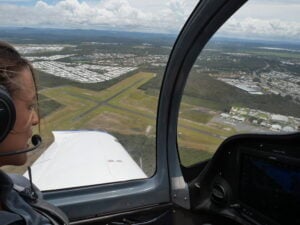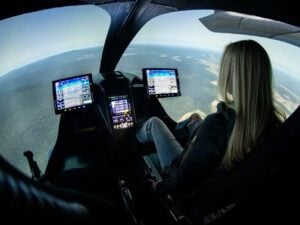Tag: RAAUs
-
Will electric VTOL aircraft replace personal fixed-wing flying?
I have owned a Flight School for over 10 years now. The majority of our students are learning to fly for fun. The majority of recreational flight students have no ambition to turn their passion for flying into a career; they just want to learn for the sheer joy of flying.
The next aviation revolution
Currently there is a ‘quiet’ revolution going on with electric VTOL (vertical take-off and landing) technology. There are roughly 80 new start-up companies world-wide, designing, flight testing and trying to certify passenger carrying electric VTOL aircraft.
Some of these companies have had close to a billion dollars of private equity investment. Some of the most promising electric VTOL start-ups include Joby Aviation, Lilium, Kittyhawk, Archer and Beta, and then there are the big aerospace companies such as Airbus, Boeing and Embraer, all working on their own designs.
These companies are focusing on urban transport and are designing and certifying these new types of aircraft for affordable mass passenger travel. These aircraft only have a limited range (usually around 200km), however this satisfies densely urban transport such as city to airport transfers. Compared to current helicopters, the cost is projected to be up to five to ten times more affordable than current helicopter technology with less than half of the noise. This future VTOL market is estimated to be worth around a trillion dollars globally by mid-2035.
The effects on learning to fly
What has not really been discussed, is how this new technology will impact personal flying and in particular, personal fixed-wing flying. While most new startups are focused on the mass transport of passengers, some companies such as Jetson One and Air One are focused on the recreational pilot market.
Startup company, Air, an Israeli-based start-up, is solely focusing on the personal recreational market with their Air One electric VTOL aircraft. While the full-scale prototype is set to fly later this year, the initial performance projections are impressive, with a one-hour range at around 90 knots with 30 minutes reserve, and it can carry two people. The aircraft has eight electric motors and a ballistic recovery system (BRS chute) for additional safety. The Air One also will have AI (artificial intelligence) self-diagnostic software that will complete the majority of the pre-flight inspections on most of the systems on behalf of the pilot. Projected sale costs are similar to an upper-end of the market Light Sport Aircraft (LSA).
Will students still want to fly fixed wing, VTOL or both?
Will future recreational pilots wish to continue flying fixed-wing aircraft or will they see electric VTOL as a better alternative? There are a few things to consider when trying to guess the answer.
Most recreational pilots fly locally
While most of our students continue on to complete their navigation and passenger endorsements, the majority of pilots who fly for fun are content to fly locally (within 50 nautical miles of the departing aerodrome). Most recreational pilots just want to get up in their local airspace and enjoy the freedom of flying and maybe share it with a friend or family member.
Those students who want to fly longer distances, have usually learned for business-related reasons and end up purchasing their own aircraft to save regularly having to drive long distances.

Learning to land is the hardest part of flying
Most people can be taught the basics of flying a plane, in a small amount of time. Landing however, is what separates the serious students from those who just think it will be cool to have a pilot’s licence.
It appears that piloting these new VTOL aircraft will be substantially easier than flying a fixed-wing aircraft. For instance, the take-off and landing in most of these VTOL aircraft will be computer-assisted. The pilot will not be responsible for basic stability in the hover, as is a helicopter pilot.
While mastering landings in a fixed-wing aircraft is rewarding, and some students love the challenge, I’m sure there are plenty of would-be students who would prefer this was a lot easier.
Runways optional
The other huge benefit for VTOL is that no runway is required. Theoretically they can take off and land almost anywhere.
While there are start-up companies working on this issue such as Skyportz, it will be a while before there are mass urban take-off and landing sites available for all VTOL types of flying, not to mention charging stations. The other factor is whether these sites will be available for personal use or only for commercial applications.
Range
Initially, range will be the biggest issue for early VTOL aircraft, the same as for early electric fixed-wing aircraft. I believe that within 10 years there will be hybrid VTOL (vertical take-off with a fixed-wing component, such as the start-up Beta, that can actually take off and land as a fixed-wing aircraft and have a range close to 400km.
Battery technology is also improving at a rate of about 5 to 7% per year. This means that within 10 years, energy density should double. This is not taking into account any major breakthroughs in battery technology (such as solid-state batteries).
Picture courtesy of Beta Technologies
 The future is exciting
The future is exciting While it is hard to predict the future, I think the personal VTOL aircraft revolution is still four to eight years away and when it arrives it is going to radically change urban transport and bring helicopter-like charter operations to the masses (rather than just the rich!).
There will still be plenty of individuals who will want to learn to fly in a fixed-wing aircraft. There is something magical about mastering a landing in a fixed-wing aircraft and as all pilots know, you never stop perfecting your landings. However, I think flying a recreational VTOL will also be rewarding in new ways. It is possible that this new technology will open up new opportunities and entice more tech-savvy pilots into the recreational flying space.
I can envision a future where a flight school has both electric fixed-wing aircraft and electric VTOL aircraft. Some pilots will be attracted to one type and some pilots will want to do both. The issue over the next five to eight years will be deciding who will manage the training and regulatory/safety aspect of these recreational VTOL type aircraft.
While Commercial VTOL will be governed by CASA in Australia, who will take the regulatory lead with recreational VTOL aircraft? For instance in Australia, will it be governed directly by CASA, or by Recreational Aviation Australia, or some new self-administering organisation?
I don’t have the answers, but I think we need to start having the conversation now so we can all have a part in creating our flying (for fun) future. While it’s impossible to predict exactly what the future will hold, there is no doubt that the future of personal flying will be very exciting.
Damien Wills, CEO GoFly Group
Feature photo courtesy of Air One
7 Day
FREE
Trial
Get access to the complete catalogue of your chosen subscription level for 7 days. After your free trial, your paid subscription automatically commences. Cancel anytime.
Get FREE TrialOur
Partners


